Shirak (Armenian: Շիրակ) is a province (marz) of Armenia. It is in the north-west of the country, bordering Turkey in the west and Georgia in the north. Its capital is Gyumri. Shirak is known as the homeland of khash. It is as much semi-desert as it is mountain meadow or high alpine. In the south, the high steppes crash into mountain terrain, verdant green in the spring, hues of reddish brown in the summer. Shirak is served by Shirak International Airport near Gyumri.
Vahramapert
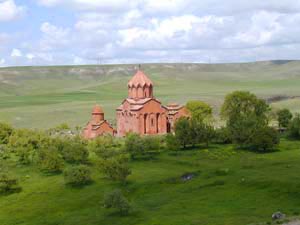
Pic. 1 | Pic. 2 | Pic. 3 | Pic. 4 |
| Named for the military leader Vahram Pahlavouni, Vahramapert is home to the 11th Century Marmashen, one of Armenia’s greatest and most beautiful church complexes, including the men’s and ladies’ cemeteries and Pahlavouni’s tomb. Marmashen’s picturesque location overlooking the Akhuryan Gorge, a waterfall and adjacent meadows, also make it a good place for a picnic, swimming, hiking and other pastimes. Also look for Urartian cuneiform inscriptions in Vahramapert. |
Harij
The Harij monastery, 7th to 13th Centuries, was built with giant multicolored stones -- each 3.5 meters wide. It is adjacent to the 7th Century St. Grigor Church. For centuries, Harij was the summer seat of Armenian Catholicoi who preferred the region’s cool nights to the heat of Etchmiadzin. Also of interest in the village are the ruins of the 5th Century Church of the Resurrection, a 13th Century chapel and the village history museum created by a local history teacher and offering an overview of the region’s rich history. Visitors will want to record their impressions in a log that will be carefully presented to them by the museum’s employee. You may also want to visit Artik, home of the famous pink Artik tuff, along the way.
|
|
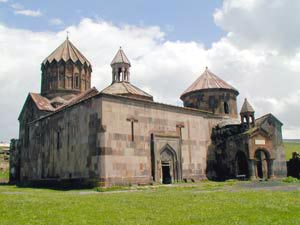
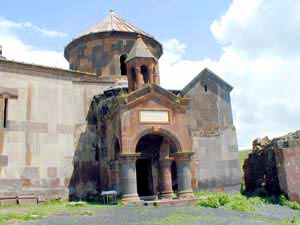 |
Toparli The famous Tsak Kar (literally hole stone) is a pagan monument in this pretty mountain village –– a huge stone with a hole just big enough for a person to squeeze through. Legend has it that people who pass through the hole will acquire eternal happiness, and villagers love to tell stories of fat people who have spent hours trapped in the hole! Beyond Toparli is Tarband, a remarkably well preserved but sparsely populated village with interesting stone walls and streets and a lovely old church.
Ashotsk Region
| The small villages of the Ashotsk Region, such as Pokr Sariar, Ghazanchi, Gakavasar (formerly known as Kefli, or Joyous) perched on the sides of hills and surrounded by miles of wildflower meadows are some of Armenia’s prettiest places. Visitors can be overwhelmed with the hospitality of these remote villages, whose rough climate imparts a special goodness to the honey, home-churned butter, |
| 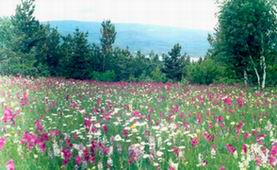 |
yogurt and wild greens on the table in every house. Cows and sheep grazing on flowers, friendly shepherds ready to point out edible greens in the fields and unique species of birds make the Ashotsk region a great place for hikers.
Lake Arpa
 |
| Tucked away in the northwest corner of Shirak, Lake Arpa is one of the world’s most ecologically important lakes, supporting several unique and endangered species of wildlife. Arpa, with its 20 square kilometer surface area and maximum depth of only 8 meters, is fed by the Yeghnajur, Karmrajur and Elal Rivers. |
In turn, it is the source of the Akhuryan River.
Beniamin
| See archeological excavations of building foundations, columns, streets and other artifacts from 5th Century B.C. Achaemenid times. The excavations are ongoing and new finds are revealed regularly. Tourists are welcome to visit and see what has been uncovered so far. |
| 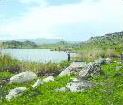 |
Horom The present village is located on the site of what was once a large city, some of whose 6 meter wide streets have been preserved and are still in use. Inscriptions can be seen on stones in and around the village. Horom is also one of a number of villages with large Armenian Catholic communities.
Sarnaghbyur
 |
| Sarnaghbyur, visited by St. Gregory the Illuminator, is home to three ancient church complexes, the ruins of still older churches, and numerous “khachkars” (stone crosses). Lmbatavank (also known as St. Stepanos of Sarnaghbyur) is of unknown age but has existed since at least the 11th Century. |
And Hogevank and Karmir Vank, (Dzoragiugh Abbey), including the Karapet Church built in 1205, are two of the most significant religious sites in Armenia. Near Sarnaghbyur you can also see the ruins of the St. Tadevos and St. Hakob churches, once connected by stone corridors clearly visible in the ruins. Sarnaghbyur is a good place to search for khachkars, which dot the landscape, some dating as far back as the 5th Century. Also, this region is famous for manufacturing “tonirs,” the clay ovens used to bake lavash and other Armenian specialties.
Mantash
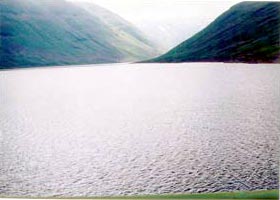 |
| The Mantash Reservoir is one of Shirak’s most beautiful places. Containing over 8 million cubic meters of water at an altitude of 2,600 meters above sea level, the reservoir is a favorite destination for fishermen out to catch the famed “karmrakhayt" (alabalagh) trout in which the waters abound. |
Ani Pemsa Dotted with quarries for the famed pink and honey-colored Ani tuff, Ani Pemsa is home to the 5th Century Yererouyk Basilica, considered to be one of the finest large ancient buildings in Armenia. Villages nearby Ani Pemsa are home to many Yezdis – semi-nomadic Christian Kurds.
Jrapi Jrapi is located near the scenic Akhuryan Reservoir (also known as “Turki Litdj” or Turk’s Lake) through which the Armenian-Turkish border runs. Though much of the Reservoir is off limits to the public, there are adjacent waterways for swimming and fishing. A famous 11th Century caravansaray and an old church were relocated to a hill overlooking Jrapi when the reservoir was built making an attractive place for hikers and picnickers. The ancient Tignis monastery and fortress are visible across the border in Turkey.
Lmbatavanq








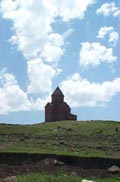




No comments:
Post a Comment